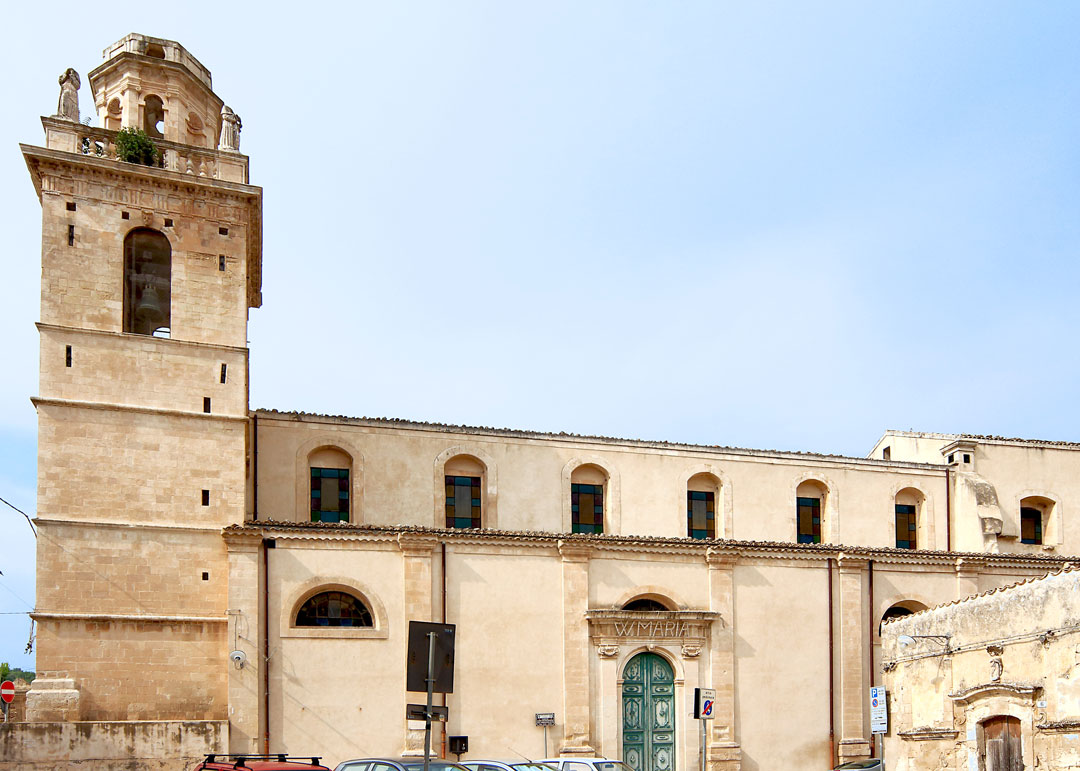Portami Qui

 La chiesa di San Francesco all’Immacolata fu edificata nel secolo XIII ma ha subito numerosi rifacimenti per cui l’aspetto attuale risale ai primi anni del secolo XVIII. Della chiesa duecentesca sono rimasti la base del campanile e il portale di stile gotico che prospetta nell’adiacente giardinetto. All’interno, i pilastri che dividono le navate mostrano ancora i segni degli scossoni dovuti al terremoto del 1693. Pregevoli i tre altari settecenteschi in marmi policromi e il quadro dell’Immacolata di Antonino Manno.
La chiesa di San Francesco all’Immacolata fu edificata nel secolo XIII ma ha subito numerosi rifacimenti per cui l’aspetto attuale risale ai primi anni del secolo XVIII. Della chiesa duecentesca sono rimasti la base del campanile e il portale di stile gotico che prospetta nell’adiacente giardinetto. All’interno, i pilastri che dividono le navate mostrano ancora i segni degli scossoni dovuti al terremoto del 1693. Pregevoli i tre altari settecenteschi in marmi policromi e il quadro dell’Immacolata di Antonino Manno.
 Although the church of San Francesco all’Immacolata was built in the thirteenth century, its aspect today dates back to the eighteenth century. In fact the church was restored several times. The bases of the bell tower and the main entrance in gothic style belonged to the original thirteenth century church. Inside, the columns that divide the naves still show some marks caused by the earthquake in 1693. Three valuable altars dating back to the eighteenth century in multicolored marbles and the painting of the Immaculate Conception by Antonino Manno.
Although the church of San Francesco all’Immacolata was built in the thirteenth century, its aspect today dates back to the eighteenth century. In fact the church was restored several times. The bases of the bell tower and the main entrance in gothic style belonged to the original thirteenth century church. Inside, the columns that divide the naves still show some marks caused by the earthquake in 1693. Three valuable altars dating back to the eighteenth century in multicolored marbles and the painting of the Immaculate Conception by Antonino Manno.
 L’église de San Francesco all’Immacolata fut batie dans le XIIIme siècle mais les nombreux restaurations lui donnent un aspect remontantant aux premières années du XVIIIme siècle. La base du clocher et le portail de style gothique appartiennent à L’ancienne église du XIIIme siècle. A l’intérieur,les colonnes qui divident les nefs ont encore les signes du tremblement de terre du 1693. Il y a des nombreuses pierres tombales sur le dallage. Le trois altars du XVIIIme siècle en marbre multicolore et la portrait de la Vierge par Antonio Manno sont vraiment digne d’attention.
L’église de San Francesco all’Immacolata fut batie dans le XIIIme siècle mais les nombreux restaurations lui donnent un aspect remontantant aux premières années du XVIIIme siècle. La base du clocher et le portail de style gothique appartiennent à L’ancienne église du XIIIme siècle. A l’intérieur,les colonnes qui divident les nefs ont encore les signes du tremblement de terre du 1693. Il y a des nombreuses pierres tombales sur le dallage. Le trois altars du XVIIIme siècle en marbre multicolore et la portrait de la Vierge par Antonio Manno sont vraiment digne d’attention.
 Die Kirche San Francesco all’Immacolata wurde in 13. Jahrhundert erbaut, aber zahlreichen Neufassungen unterworfen, so dass das heutige Aussehen auf den Anfang des 18. Jahrhundert erbauts zurückgeht. Aus dem 13. Jahrhundert sind noch das Fundament des Glockenturms und das Portal im Stile Friedrichs, das auf den angrenzenden Garten hinausgeht. Beachtenswert sind die drei Altäre aus dem 17. Jahrhundert in mehrfarbigem Marmor und das Bild der heiligen Jungfrau von Antonino Manno.
Die Kirche San Francesco all’Immacolata wurde in 13. Jahrhundert erbaut, aber zahlreichen Neufassungen unterworfen, so dass das heutige Aussehen auf den Anfang des 18. Jahrhundert erbauts zurückgeht. Aus dem 13. Jahrhundert sind noch das Fundament des Glockenturms und das Portal im Stile Friedrichs, das auf den angrenzenden Garten hinausgeht. Beachtenswert sind die drei Altäre aus dem 17. Jahrhundert in mehrfarbigem Marmor und das Bild der heiligen Jungfrau von Antonino Manno.


